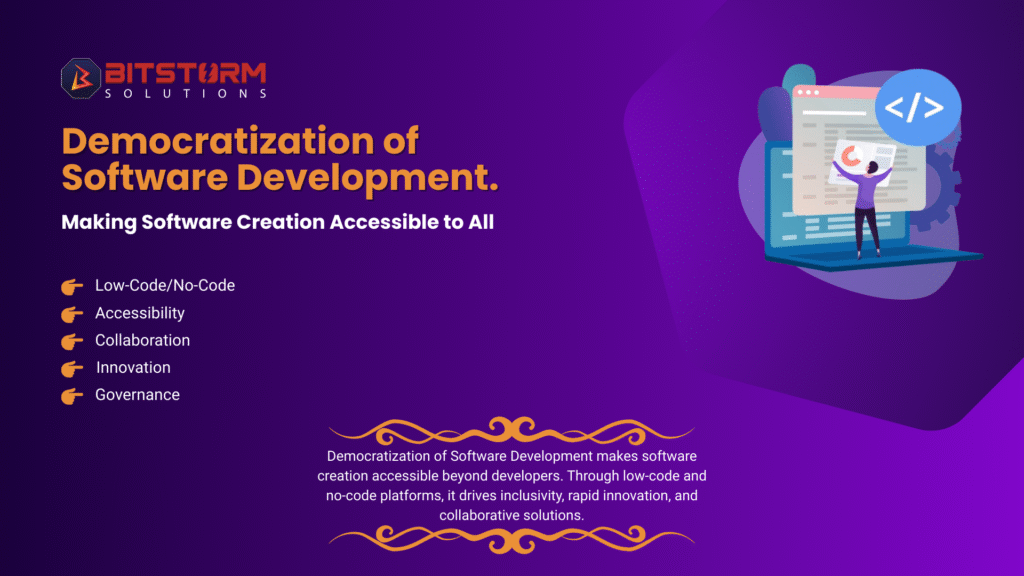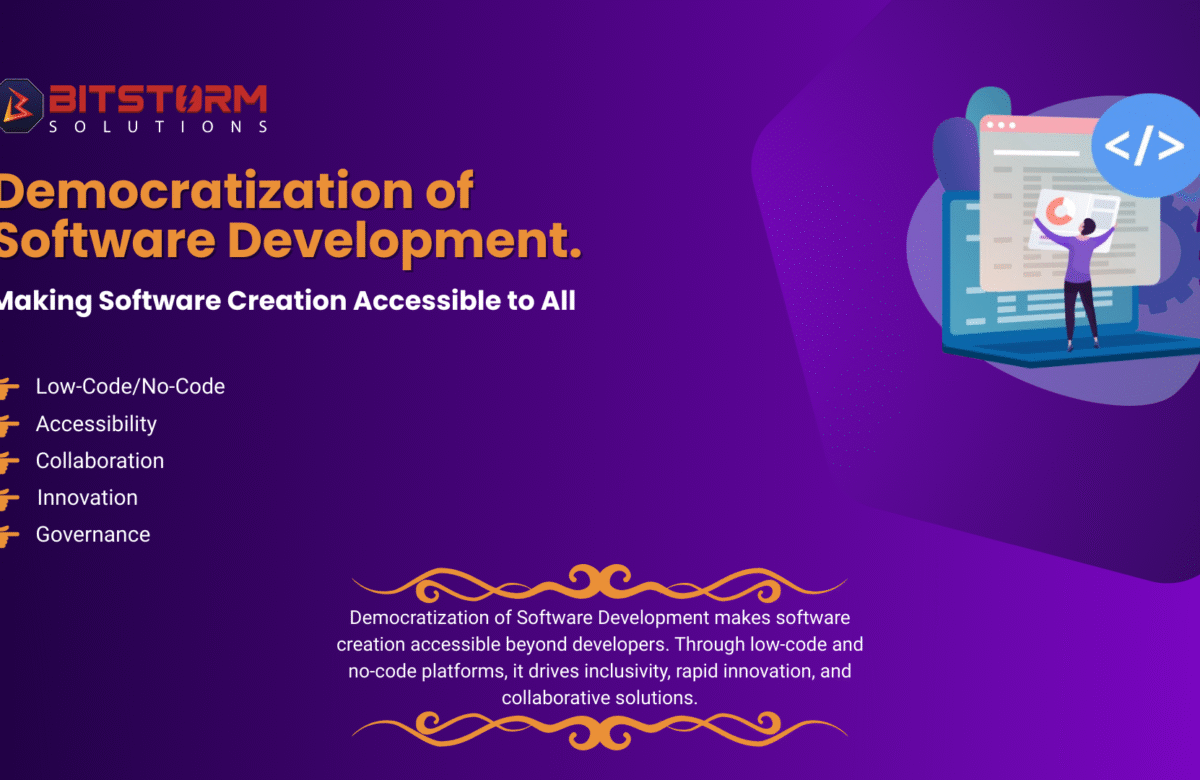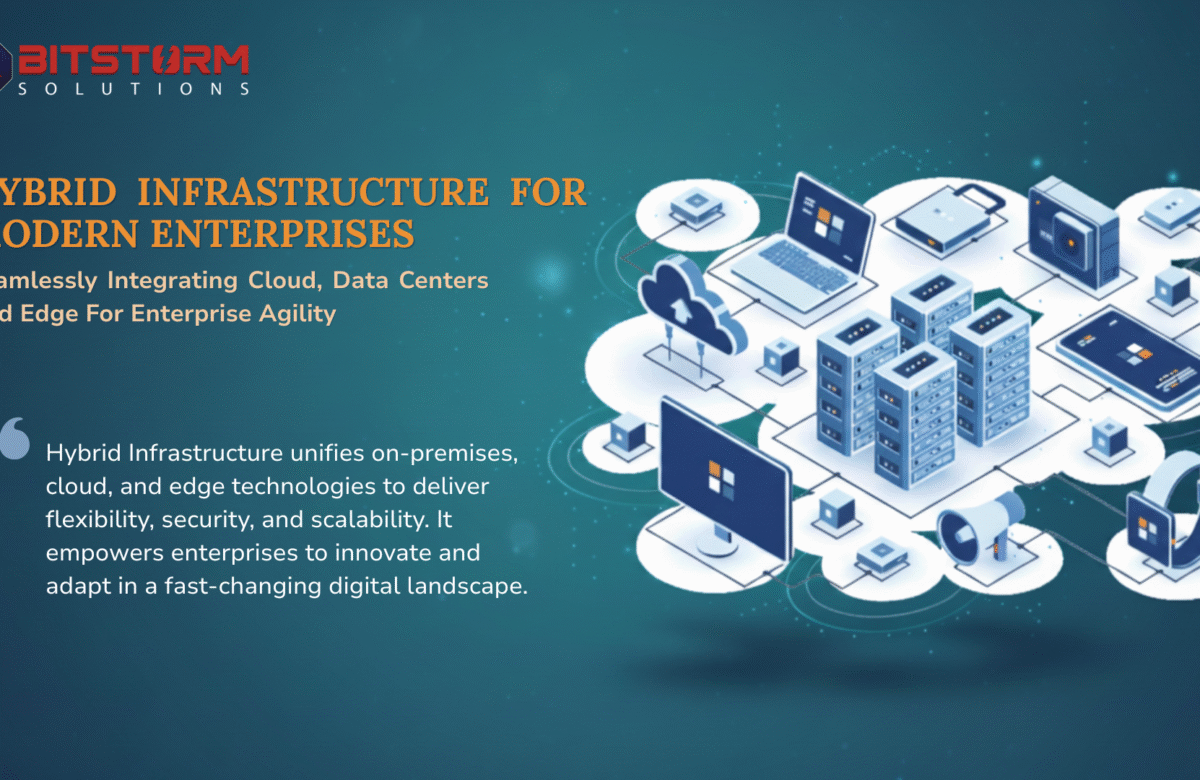
Introduction
Technology has become the backbone of modern business, influencing everything from customer engagement to operational efficiency. Yet for decades, software development remained confined to skilled programmers, creating a gap between business needs and technical capabilities. This gap often slowed down innovation, increased costs, and limited opportunities for rapid digital transformation.
Today, that landscape is changing. With the rise of low-code and no-code platforms, the ability to design, develop, and deploy applications is no longer exclusive to developers. Instead, software creation is becoming accessible to professionals from all backgrounds, marketers, entrepreneurs, educators, and healthcare experts alike. This paradigm shift is known as the Democratization of Software Development, and it is fundamentally redefining how organizations build solutions and innovate at scale.
What is Democratization of Software Development?
Democratization of Software Development refers to the process of opening up software creation to a wider audience beyond professional coders. By simplifying development tools, automating workflows, and providing intuitive interfaces, businesses can empower employees at all levels to contribute to innovation.
At its core, this concept emphasizes accessibility, inclusivity, and collaboration ensuring that ideas are no longer limited by technical expertise. Whether it’s building a custom workflow automation, designing a mobile app, or streamlining internal processes, democratization makes it possible for more people to take part in shaping digital solutions.
The Core Pillars of Democratization
1. Low-Code and No-Code Platforms
The foundation of democratization lies in low-code and no-code technologies. These platforms allow users to build applications with drag-and-drop interfaces, pre-built components, and visual workflows. While low-code platforms still involve some programming for customization, no-code solutions eliminate the need for coding altogether.
For organizations, these platforms accelerate project delivery, reduce dependence on scarce technical talent, and provide cost efficiency. For individuals, they unlock the power to create digital solutions without years of training in software engineering.
2. Accessibility
One of the biggest barriers in traditional software development is complexity. Democratization eliminates this barrier by making tools user-friendly and widely available. Professionals from non-technical fields such as finance, logistics, healthcare, or marketing can design apps that directly address their challenges.
This accessibility not only empowers individuals but also reduces bottlenecks within organizations, as departments no longer have to wait months for IT teams to prioritize their requests.
3. Collaboration
Democratized software development thrives on collaboration between technical and non-technical teams. Developers bring depth and expertise, while business professionals bring context and practical knowledge of real-world problems. Together, they create solutions that are both technically sound and business-aligned.
This cross-functional teamwork ensures that innovation is not confined to a single department but becomes a shared responsibility across the organization.
4. Innovation
When more people can contribute to building software, innovation multiplies. Fresh perspectives lead to creative problem-solving and unconventional approaches. Instead of relying solely on IT teams to propose solutions, organizations benefit from ideas that emerge from all levels of employees who understand the customer journey, internal workflows, or specific industry needs.
In many ways, democratization unlocks untapped creativity within organizations, helping them stay agile and competitive in a digital-first world.
5. Governance
Accessibility and innovation are powerful, but without governance, they can create challenges around security, compliance, and scalability. Governance ensures that applications built through low-code and no-code platforms meet organizational standards.
Well-defined governance frameworks balance freedom with accountability, ensuring that innovation happens responsibly, without compromising on data protection or operational integrity.
Why Democratization Matters in Today’s World
Faster Time-to-Market
In a competitive environment, speed is a decisive factor. Democratized development shortens the application lifecycle, enabling organizations to roll out solutions quickly and respond to market changes in real time.
Cost Efficiency
Hiring and training developers can be expensive. By empowering non-technical staff to contribute, businesses reduce reliance on specialized resources while optimizing development costs.
Bridging the Skills Gap
The global shortage of skilled developers is a well-documented challenge. Democratization helps bridge this gap by distributing development capabilities across a broader workforce.
Driving Inclusivity
By lowering entry barriers, democratization fosters inclusivity. It gives diverse voices the opportunity to shape technology, leading to solutions that better represent a wider range of perspectives and needs.
Building a Culture of Innovation
When employees at every level have the tools to innovate, organizations develop a culture of experimentation and problem-solving. This not only drives productivity but also improves employee engagement and retention.
Real-World Applications
The impact of democratized development can already be seen across industries:
Healthcare: No-code apps help clinics digitize patient records and streamline appointment scheduling.
Education: Teachers use low-code tools to create learning management systems tailored to their classrooms.
Retail: Businesses design custom inventory management systems without heavy IT involvement.
Finance: Teams build compliance tracking applications to meet regulatory standards faster.
These examples highlight how democratization empowers industries to adapt quickly to evolving needs without relying solely on traditional software pipelines.
Challenges and Considerations
While the benefits are clear, democratization also introduces challenges that organizations must address:
Quality Control: Without governance, there’s a risk of poorly designed applications that may not scale.
Security Risks: Increased accessibility requires stricter policies to safeguard sensitive data.
Over-Reliance on Tools: Organizations must avoid depending too heavily on platforms without building long-term technical strategies.
By combining empowerment with oversight, businesses can mitigate these risks while maximizing the benefits of democratization.
Conclusion
The Democratization of Software Development is more than just a technological shift it is a cultural and organizational transformation. By embracing low-code/no-code platforms, accessibility, collaboration, innovation, and governance, businesses can unlock new levels of agility and inclusivity.
This movement ensures that great ideas are no longer limited by technical barriers. Instead, they are transformed into real solutions by the very people who understand the problems best. The future of software development will not belong to a select few, it will belong to everyone with the vision to create and the tools to bring that vision to life.
The future of retail will belong to those who leverage intelligence, not assumptions.



